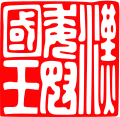Cartridge (art)
A cartouche is a decorative frame in ornamentation . Cartridges can frame coats of arms , portraits , paintings or inscription fields. Cartouches were mainly used from the Renaissance to the Rococo and again in historicism . Cartridges were and are in use in a wide range of arts and crafts, including architecture .
etymology
The term cartouche comes from the Greek χάρτης - chártēs and Latin charta and means something like "papyrus bush", "papyrus roll", "papyrus sheet", "paper", "paper sheet". The word was borrowed from the French cartouche , which is based on the Italian cartoccio and has the meaning of "cardboard tube". The frequently curling corners and edges of the cartouches correspond to this etymology. If a cartridge frames an image, the term cartridge image exists for this .
Cartridges in architecture
Cartouches were popular forms in the architecture of the Renaissance and Baroque in particular, and they often served as decoration themselves without being filled with any content. As defined in architecture, they differ from picture frames in that they are not mobile, but rather a sculptural component of the surrounding architecture.
The Dutch cartouche with roll and cartilage ( bat wings , dog ears ) was used in the French classical period in the Louis XIII style . An example of this is Cheverny Castle . In the French form, these cartridges were elongated, as in Paris, St-Gervais and Fontainebleau .
Maison du Cerf in Brussels
Upper Belvedere in Vienna
Another example of an over-the-door cartridge: Tyska Skolgränd in Stockholm
Example of a stucco cartouche in the Boulbonne monastery
Different definitions
Definitions of the art terms cartouche and cartouche image that differ from those in architecture, which among other things do not aim at the delimitation feature of immobility, exist, for example, in the art of Japanese color woodcut , in seal carving , as a term cartouche in Egyptology , in letterpress and usually in the painting (except mural ). As a pure art term, cartridge is defined predominantly independently of the mobility issue and the material.
Example of a cartouche in Egyptology: Name of King Menes
Example of an inscription cartridge on a map by Johannes Mejer
Painting by Sebastián Muñoz with two cartridge inclusions
literature
- Bodo Hedergott: The cartouches - the life story of a form , dissertation, Göttingen 1955.
- Wilfried Koch: Architectural style - European architecture from antiquity to the present , Orbis-Verlag, Munich 1988, ISBN 3-572-05927-5 , p. 318 (French classic Louis XIII 1610-43 bat wings , dog ears , see Cheverny Castle; elongated French form, see Paris, St-Gervais and Fontainebleau).
- Jacques Derrida: "Cartridges". In: ders .: The truth in painting , Vienna 1992, pp. 219–300.
- Hans Körner: "Framing and engulfing. Metamorphoses of the cartouche". In: Hans Körner and Karl Mösender (Eds.): Frame - Between Inside and Outside. Contributions to theory and history , Berlin 2010, ISBN 978-3-496-01421-8 , pp. 41–62.
- Constanze Köster: Cartouche pictures with flower wreaths and fruit garlands: on the development and interpretation of a genre of still life in the 17th century , LIT Verlag Berlin, Münster a. a. 2012, ISBN 978-3-6431-1682-6 (revised edition of her master's thesis The sacred motif in still life , University of Kiel 2011).
- Karin Leonhard: Broadening the margins: for the cartridge image in the 16th and 17th centuries . In: Bernhard Huss et al. (Ed.): Mannerism: Interdisciplinary studies on an aesthetic style type between formal experiment and historical significance , Heidelberg 2014, ISBN 978-3-8253-6239-3 , pp. 285–306 ( Germanic-Romanic monthly journal : supplement 56).
- Joachim Möller (Ed.): Cartridges - Shape and Message of an Ornament , Dinslaken 2018. ISBN 978-3-00-059204-1
Web links
- The large art lexicon by PW Hartmann , especially the keyword "cartridge"
- Style development and spread in the transition from the Middle Ages to the modern age - What was the Renaissance? (PDF) University Library Center of the State of North Rhine-Westphalia .
Footnotes
- ↑ Ekyōdai is the Japanese technical term for a cartridge image in Japanese color woodcut
- ↑ see e.g. B. in Diccionario de la Academia española , edición abreviada, por D. Vicente González Arnao, París, en la Librería de Parmentier, 1826











